The Relationship between Bosnian Identity and Islam.
The Significance of European History as an Identity-shaping Element before World War I
Abstract
Although the analysis of the ethnic composition of society was not a defining characteristic in Bosnia and Herzegovina before the 1990s, after the Yugoslav wars and following 9/11, the
western world started to extend its general stigmatizing narrative to European Muslims too. In order to define a Bosnian identity with European roots, the times before the Turkish conquest of the province in 1460 must be scrutinised. The aim of this study is to explore the roots of Bosnian Muslim (Bosniak) identity, to analyse its relationship with Islam, and to review the common European past as an identity-forming element.
References
Alibašić, Ahmet 2007. The Profile of Bosnian Islam and What West European Muslims Could Benefit from It. https://www.akademiers.de/fileadmin/user_upload/download_archive/interreligioeser-dialog/071116_albasic_bosnianislam.pdf (Letöltve: 2024. 12. 15.)
A Magyar Katolikus Egyház történeti kronológiája.https://regi.katolikus.hu/kronologia.php?h=313 (Letöltve: 2025. 01. 25.)
Binder Tamás (szerk.) 2022. Bosznia-Hercegovina, a mesélő emberek földje.
Budapest: Katonai Nemzetbiztonsági Szolgálat.
Boda Mihály 2023a. A háborús ideológiák története – A háború igazolása Nyugat-Európában és Magyarországon az ókortól a 20. század végéig. Budapest: Ludovika Kiadó.
Boda Mihály 2023b. Az oszmán török háborús ideológia és a Magyar Királyság. In: „Zászló alá magam csaptam fel” Ünnepi tanulmányok a 65 éves Csikány Tamás dandártábornok tiszteletére. Szerk. Kiss Péter, Petrik Iván és Toldi Lóránd. 25–36. Budapest: Ludovika Kiadó.
Borosy András 1996. A keresztes háborúk és Magyarország. Budapest: Argumentum Kiadó. https://epa.oszk.hu/00000/00018/00081/pdf/EPA00018_hadtortenelmi_1996_02_011-054.pdf (Letöltve: 2025. 01. 03.)
Bringa, Tone 1997. Biti musliman na bosanski naèin: identitet i zajednica u jednom srednjobosanskom selu. (Biblioteka Dani) Sarajevo: Dani.
Budapest főváros törvényhatósági bizottsága közgyûlési jegyzőkönyvei 1914–19. https://library.hungaricana.hu/hu/view/BPSZKJ_1914/?pg=691&layout=s (Letöltve: 2025. 01. 12.)
Can, Mehmet 2012. Austria-Hungary Dinasty Period in Bosnia. Sarajevo, 2012.
Communities and Cultures, Conference Proceedings. Sarajevo, 16–18 October 2009.
Convention between Austria-Hungary and Turkey, relative to the Occupation of Bosnia-Herzegovina, signed at Constantinople, 21 April 1879.
Fine, John 1975. The Bosnian Church Its Place in State and Society from the Thirteent to the Fitheenth Century. New York: Columbia University Press.
Imamović, Mustafa 2003. Bošnjački etnos: identitet i ime. Prilozi, 32 (Sarajevo, 2003). 315–329.
Islamic Community in Bosnia and Herzegovina https://islamskazajednica.ba (Letöltve: 2025. 01. 10.)
Iszlám 100 – Tudományos konferencia az iszlám 1916. évi magyarországi elismerésének 100. évfordulóján. Eötvös Loránd Tudományegyetem, Bölcsészettudományi Kar Vallástudományi Központ http://vallastudomany.elte.hu/sites/default/files/iszlamkonf/Elo%CC%8Bado%CC%81k%20e%CC%81s%20o%CC%88sszefoglalo%CC%81k.pdf (Letöltve: 2025. 01. 12.)
Kriještorac, Mirsad 2022. First Nationalism then Identity On Bosnian Muslims and Their Bosniak Identity. University of Michigan Press.
Malcolm, Noel 2019. Useful enemies: Islam and the Ottoman empire in Western political thought, 1450–1750. Oxford University Press.
Muhić, Ferid 2011. The Otoman legacy as a common layer of the Balkan muslim Identites. In: Surviving Elements of Ottoman legacy in the Balkans in Non-Muslim Communities and Cultures. Conference Proceedings.
Sarajevo, 16–18 October 2009. Edited by: dr. Halit Eren. 29–38. Sarajevo: Arka Press.
Mulalić, Muhidin; Topcu, Emel; Muhasilović, Jahja 2022. The Western Balkans Cooperation, Geopolitics and Economic Transitions and Relations. Szarajevo: International University of Sarajevo.
Mustafa Imamović 2006. Historija Bošnjaka. Sarajevo: Bošnjačka Zajednica Kulture Sarajevo. Muzej Bosanskog Kraljevstva: Ban Kulin. https://muzejbosanskogkraljevstva.ba/en/ban-kulin-2/ (Letöltve: 2025. 01. 25.)
Olalde, Inigo; Carrion, Pablo; Mikic, Ilija, Grbic, Miodrag; Lalueza-Fox, Carles, Reich, David 2023. A genetic history of the Balkans from Roman frontier to Slavic migrations. Cell, 186 (25): 5472–5485.https://www.sciencedirect.com/science/article/pii/S0092867423011352 (Letöltve: 2025. 01. 10.)
https://doi.org/10.1016/j.cell.2023.10.018 Oruç, Hatice 2009. Administrative Division of the Bosnian Sandjak in the 16th Century. 16. Yüzyýlda Bosna Sancaðý’nýn Ýdarî Daðýlýmý. OTAM, 25 (2009). 99–147. https://www.ajindex.com/dosyalar/makale/acarindex 1423910765.pdf (Letöltve: 2025. 01. 10.)
Padányi József 2004. Békefenntartás Boszniában: a Magyar Mûszaki Kontingens. (Védelmi tanulmányok 53.) Budapest: Zrínyi Miklós Nemzetvédelmi Egyetem Stratégiai Védelmi Kutatóközpont.
Popis Bosanskog sand_aka iz 1604. godine – jasan dokaz o velikom procentu širenja Islama među stanovništom. 2022. https://bosnae.info/index.php/popis-bosanskog-iz-1604-godinejasan-dokaz-o-velikom-procentu-sirenja-islama-medu-stanovnistom-2 (Letöltve: 2025. 01. 12.)
Radišić, Nikolina 2016. Pad Srbije i Bosne pod Osmansko Carstvo. Osijek: Sveučilište Josipa Jurja Strossmayera u OsijekuFilozofski fakultet. https://repozitorij.ffos.hr/islandora/object/ffos:605/datastream/PDF/view (Letöltve: 2025. 02. 09.)
Rastoder, Melita 2012. The Bosniak/Muslim Identity in the Sandjak: Prospects and Challenges. Master’s Thesis. Izmir, 2012. https://avesis.deu.edu.tr/dosya?id=794b237e-8c5a-4d34-8cc1-cff0e4ea55c1 (Letöltve: 2025. 01. 09.)
Šabanović, Hazim 1959. Bosanski pašaluk – Postanak i upravna podjela. Sarajevo: Oslobodenje.
Seferović, Selena 2006. Govor zavièaja: Kulturne aktivnosti u Bosansko-Hercegovaèkoj Zajednici 1991–2006. Chicago: Bosanska biblioteka Čikago.
Szalai Miklós 2010. Az 1916. évi VII. törvénycikk – Az iszlám vallás legalizálása Magyarországon. Történelmi Szemle, 52 (4): 593–602.7 https://tti.abtk.hu/images/kiadvanyok/folyoiratok/tsz/tsz2010-4/593-602_szalai.pdf
Dr. Szûcs Lászlóné dr. Siska Katalin 2016. Guy Burak 2016. The Second Formation of Islamic Law. The Hanafi School in the Early Modern Ottoman Empire recenzió Pro Publico Bono – Magyar Közigazgatás, 2016/1, 166–173.
Ternovácz Bálint 2013. A bogumil eretnekség az Észak-Balkánon a 10–11. században. In: Főbb tendenciák a 10–11. századi balkáni bogumilizmus kutatásában. Micae Medievales III. Fiatal történészek dolgozatai a középkori Magyarországról és Európáról. Szerk. Gál Judit, Péterfi Bence, Vadas András, Kranzieritz Károly. 65–76. Budapest: ELTE BTK. https://edit.elte.hu/xmlui/bitstream/handle/10831/85129/Micae%20Mediaeveles%20III_pdfa-62-73.pdf?sequence=1 (Letöltve: 2024. 12. 15.)
Ternovácz Bálint: A boszniai latin püspökség története 1344-ig. In: Micae Mediaevales V. Fiatal történészek dolgozatai a középkori Magyarországról és Európáról. Szerk. Fábián Laura, Gál Judit, Haraszti Szabó Péter, Uhrin Dorotya. 215–228. Budapest: ELTE BTK. https://edit.elte.hu/xmlui/bitstream/handle/10831/84991/Micae%20Mediaevales%20V_pdfa-216-229.pdf?sequence=1 (Letöltve: 2025. 01. 04.)
Warren, Christie S. 2013. The Hanafi School. Oxford Bibliography. Your Best Research Starts Here. https://www.oxfordbibliographies.com/display/document/obo9780195390155/obo-9780195390155-0082.xml (Letöltve: 2025. 01. 05.) https://doi.org/10.1093/obo/9780195390155-0082




